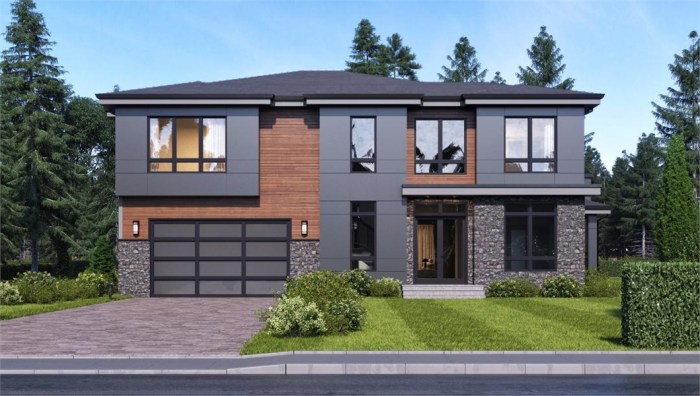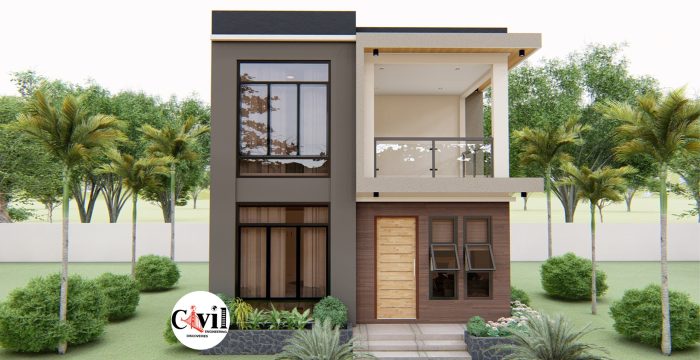Interior Design and Space Optimization

2 bedroom 2 storey house design – Designing the interior of a two-bedroom, two-story house requires careful consideration of both aesthetics and functionality. Optimizing space is crucial in maximizing the home’s livability and creating a comfortable environment. This section will explore various design styles, space-saving strategies, and color palette suggestions to help you achieve your ideal home.
Interior Design Styles for a Two-Story Home, 2 bedroom 2 storey house design
Several interior design styles complement the architecture of a two-story, two-bedroom home. A minimalist style, characterized by clean lines, neutral colors, and a focus on functionality, works well in smaller spaces, maximizing the feeling of openness. Conversely, a farmhouse style, with its rustic charm and natural materials, can create a warm and inviting atmosphere. Modern styles, emphasizing sleek lines and contemporary furnishings, offer a sophisticated look, while transitional styles blend traditional and modern elements for a balanced aesthetic.
The choice depends entirely on personal preference and the overall desired ambiance.
Maximizing Space and Storage
Efficient space utilization is paramount in a two-bedroom, two-story house. Built-in shelving and storage units in hallways and bedrooms significantly increase storage capacity without compromising floor space. Utilizing vertical space with tall bookcases or strategically placed cabinets maximizes storage while adding visual interest. Multi-functional furniture, such as ottomans with built-in storage or beds with drawers underneath, cleverly combines storage and seating/sleeping areas.
Clever use of mirrors can also create an illusion of more space by reflecting light and expanding the visual perception of a room. For example, a large mirror placed opposite a window can dramatically brighten and enlarge a small hallway.
Color Palettes and Textures to Create Moods
Color and texture play a significant role in setting the mood of each room. Light, neutral colors such as whites, creams, and light grays create a feeling of spaciousness and airiness, particularly beneficial in smaller rooms. In contrast, darker, richer colors like deep blues or greens can add warmth and coziness to bedrooms or living areas. Texture adds depth and visual interest.
Think about incorporating natural textures like wood, stone, or woven fabrics to create a sense of warmth and grounding. In the living room, plush carpets and soft furnishings can contribute to a relaxing atmosphere, while smooth, sleek surfaces in the kitchen might convey a sense of modernity and cleanliness. The interplay of color and texture is key to creating a cohesive and harmonious design throughout the house.
Sample Furniture Arrangement: Living Room
This arrangement prioritizes both comfort and functionality. A comfortable sofa placed against a wall, ideally facing a focal point like a fireplace or large window, creates a relaxed seating area. Two armchairs flank a coffee table, providing additional seating and a surface for drinks and books. A media console holds the television and other electronics, keeping them organized and out of sight.
A rug defines the seating area and adds warmth and texture. Floor lamps provide ambient lighting, while a statement piece, such as a large artwork or sculpture, adds visual interest.
Sample Furniture Arrangement: Master Bedroom
The master bedroom arrangement emphasizes relaxation and a sense of calm. A king-size bed, positioned to maximize natural light, serves as the centerpiece. Two bedside tables with lamps provide ample space for books and personal items. A dresser provides storage for clothing and accessories. A comfortable armchair with a reading lamp offers a quiet space for relaxation.
A large mirror placed strategically can create a sense of spaciousness and enhance the room’s lighting. The use of soft, natural textiles like linen or cotton adds to the bedroom’s calming ambiance.
Exterior Design and Landscaping

Creating a visually appealing exterior for a two-bedroom, two-story home involves careful consideration of several key elements. The goal is to achieve a cohesive design that enhances curb appeal, complements the home’s architectural style, and provides a welcoming atmosphere. This section will explore exterior design elements, roofing styles, landscaping options, and suitable exterior wall materials.
Exterior Design Elements Enhancing Curb Appeal
Strategic placement of windows and doors can significantly improve curb appeal. Large windows, particularly on the upper floor, can create a sense of spaciousness and elegance. Well-proportioned doors, perhaps with decorative accents like transom windows or sidelights, add character and visual interest. The use of architectural details, such as cornices, trim, and shutters, can further enhance the aesthetic appeal, adding depth and texture to the façade.
Consider a balanced symmetry or an intentional asymmetry depending on the chosen architectural style to create visual harmony. For example, a symmetrical design might feature matching windows and doors on either side of a central entrance, while an asymmetrical design could incorporate a varied arrangement of windows and doors for a more dynamic feel. Consistent use of materials, such as brick, stone, or siding, across the exterior creates a unified look.
Roofing Styles for Two-Story Homes
The choice of roofing style significantly impacts the overall appearance of a two-story home. Gable roofs, characterized by their triangular shape, are a classic and versatile option, offering good ventilation and shedding water effectively. Hip roofs, with slopes on all four sides, provide excellent protection against harsh weather conditions. Mansard roofs, with their steep slopes and dormers, create a more formal and traditional look, often seen in Victorian-style homes.
A gambrel roof, featuring two slopes on each side, with the lower slope being steeper than the upper, offers ample attic space and a distinctive appearance. The suitability of each style depends on factors such as climate, local building codes, and the desired aesthetic. For instance, a gable roof might be ideal for areas with heavy snowfall, while a hip roof could be preferred in areas prone to high winds.
Landscaping Options Complementing Architectural Style
Landscaping plays a crucial role in enhancing the curb appeal and overall aesthetic of a two-story home. The landscaping should complement the architectural style of the house. For a traditional home, a formal garden with manicured lawns, neatly trimmed hedges, and symmetrical flowerbeds might be appropriate. For a more modern home, a minimalist landscape with clean lines, native plantings, and gravel pathways could be a better fit.
The use of color in landscaping can add visual interest. For example, planting flowers with contrasting colors can create a vibrant and welcoming atmosphere. Incorporating hardscaping elements, such as walkways, patios, and retaining walls, can add structure and functionality to the landscape. Consider using materials like stone, brick, or wood that complement the exterior of the house.
A well-designed landscape should create a seamless transition between the house and its surroundings.
Exterior Wall Materials: Cost and Maintenance
Several materials are suitable for exterior walls, each with varying costs and maintenance requirements. Brick is a durable and aesthetically pleasing option, but it can be expensive. Vinyl siding is a more affordable alternative, requiring minimal maintenance. Wood siding offers a natural look, but it requires regular painting or staining to prevent rot and insect damage. Stone veneer provides a luxurious look and excellent durability, but it is typically more expensive than other options.
Designing a two-bedroom, two-story house offers many layout possibilities. A key consideration, especially when personalizing the space, is selecting the right paint colors for each bedroom. For inspiration and ideas on achieving the perfect atmosphere, check out this helpful guide on interior design bedroom paint colors to ensure your design complements the overall house aesthetic. Ultimately, thoughtful paint choices contribute significantly to the overall success of your two-bedroom, two-story home design.
Fiber cement siding is a relatively new option that combines the durability of cement with the versatility of wood. The choice of material should consider factors such as climate, budget, and aesthetic preferences. For example, in a region with harsh winters, brick or fiber cement siding might be more suitable due to their durability. In warmer climates, wood siding might be a preferred choice for its aesthetic appeal.
Building Materials and Construction

The selection of building materials and the construction process significantly impact the longevity, cost, and energy efficiency of a two-story, two-bedroom house. Careful consideration of these factors is crucial for a successful project. This section details various material options, key structural components, energy-efficient practices, and the typical construction stages involved.
Comparison of Building Materials
Brick, wood, and concrete are common choices for residential construction, each possessing unique advantages and disadvantages. Brick offers excellent durability, fire resistance, and sound insulation. However, it can be more expensive and time-consuming to construct with than other materials. Wood framing, a popular choice for its cost-effectiveness and ease of construction, provides good insulation but is susceptible to fire and insect damage.
Concrete, known for its strength and longevity, is highly resistant to fire and pests; however, it can be expensive and requires specialized expertise for proper implementation. The optimal choice depends on budget, local climate, and aesthetic preferences. For instance, in areas prone to wildfires, concrete or brick might be preferred for enhanced fire safety.
Key Structural Components of a Two-Story House
A two-story house relies on a robust structural framework. The foundation, typically concrete, provides a stable base. The framing, commonly wood or steel, supports the walls and roof. Load-bearing walls, which transfer weight from the upper floors to the foundation, are crucial for stability. The roof structure, including rafters, trusses, and sheathing, protects the interior from the elements.
Finally, the connection between the foundation and the framing is critical, ensuring the transfer of weight and resisting lateral forces like wind. A poorly constructed foundation, for example, can lead to cracks in walls and other structural issues down the line.
Energy-Efficient Building Practices
Energy efficiency is a key consideration in modern construction. Employing energy-efficient practices can significantly reduce long-term operating costs and minimize the environmental impact of the building. This includes using high-performance insulation in walls, roofs, and floors to minimize heat transfer. Double- or triple-pane windows significantly reduce heat loss and improve sound insulation. Properly sealed air gaps and airtight construction methods prevent drafts and energy leaks.
The incorporation of passive solar design, which utilizes the sun’s energy for heating and lighting, can further reduce energy consumption. Examples of such practices include strategically placing windows to maximize solar gain in winter and minimize it in summer. Additionally, the use of energy-efficient appliances and lighting systems contribute to overall energy savings.
Stages of Construction for a Two-Bedroom, Two-Story House
The construction of a two-bedroom, two-story house typically involves several sequential stages.
- Site preparation and foundation excavation
- Foundation construction (including pouring the concrete footing and foundation walls)
- Framing (erection of the walls, floors, and roof)
- Roofing (installation of the roofing material)
- Exterior finishes (siding, windows, doors)
- Interior finishes (drywall, painting, flooring)
- Mechanical, electrical, and plumbing (MEP) installation
- Final inspections and landscaping
This sequence may vary slightly depending on the specific project and construction methods used. However, these stages represent a general overview of the process. Delays in one stage can significantly impact the overall timeline, highlighting the importance of careful planning and coordination.
Essential FAQs: 2 Bedroom 2 Storey House Design
What are some common challenges in designing a 2-story house?
Common challenges include maximizing natural light on the lower floor, ensuring adequate staircase placement and size, and managing sound transfer between floors.
How much does it typically cost to build a 2-bedroom, 2-story house?
Building costs vary significantly based on location, materials, finishes, and labor costs. It’s essential to obtain detailed cost estimates from builders in your area.
What are some energy-efficient features to incorporate?
Consider energy-efficient windows, proper insulation, solar panels, and high-efficiency HVAC systems.
How can I ensure good ventilation in a 2-story house?
Good ventilation can be achieved through strategically placed windows, exhaust fans, and potentially a whole-house ventilation system.
